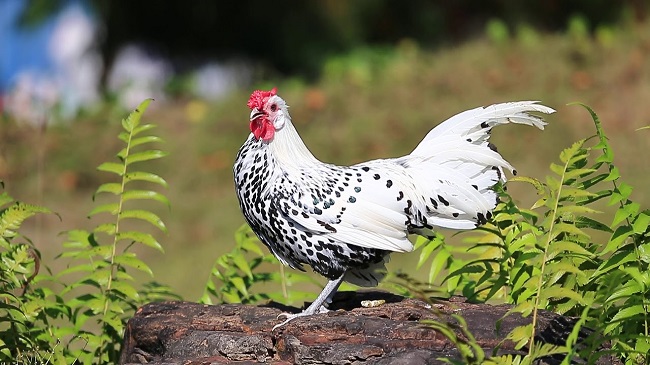The world of poultry is replete with variety, and the appeal of black and white chicken breeds extends beyond their striking appearance. Each breed carries unique traits, from excellent egg-laying capabilities to adaptability and distinctive behaviors.
This guide aims to detail ten of the most popular black and white chicken breeds, offering deep insight into their characteristics, care needs, and suitability for your backyard coop.

Breeds of Black and White Chickens
Here are some of the breeds of black and white chicken:
Read Also:
Barred Plymouth Rock
These are medium to large-sized birds, known for their robust constitution, long, broad backs, and deep, full breasts. Their black and white barred feathering is distinctive and provides excellent camouflage against predators. This breed is known for being calm and sociable, making it an excellent choice for families with children.
Sussex
The Sussex breed comes in several colors, but the Light Sussex is one of the most distinctive, with a white body and black neck and tail feathers.
Sussex chickens are renowned for their friendly nature and excellent egg-laying capabilities, often laying up to 250-275 large brown eggs per year. They are also known to be good foragers and quite hardy.
Ancona
Named after the Italian city of Ancona, these chickens are small, active, and known for their adaptability to various climates.
Their plumage is primarily black, speckled with white spots. Anconas are great egg layers, often laying up to 220 white eggs annually. They are quite flighty and prefer to be free-ranged.
Lakenvelder
The Lakenvelder breed is known for its striking black and white contrast. Despite being smaller, they’re lively and love to forage, making them perfect for free-range settings. They lay small to medium-sized white eggs and have a flighty, yet manageable temperament.
Dominique
Known as America’s oldest breed, Dominique chickens are quite similar to Barred Rocks but have a rose comb and slightly different color patterns.
They’re hardy birds, often laying about 230 medium-sized brown eggs per year. They are also known for their docile, friendly disposition and adaptability to various living conditions.
Dorking
The Dorking is one of the oldest known chicken breeds. The Silver Grey Dorking has a distinctive rectangular body shape, five toes on each foot (unlike most chickens which have four), and a calm, docile temperament. They’re decent layers, producing 140-150 tinted to white eggs per year.
Wyandotte
Wyandottes are large, hardy birds with a docile temperament. The Silver Laced Wyandotte is a variety that showcases a beautiful feather pattern of white feathers laced with black edges. They lay approximately 200 medium to large brown eggs annually.
Hamburg
The Silver Spangled Hamburg is small but incredibly active. Their white feathers adorned with black spangles at the tip create a lovely contrast. They lay small to medium white eggs and are known for their independent, flighty nature.
Orpington
Black and White Spangled Orpingtons are large, fluffy birds with a friendly and relaxed temperament. Despite their size, they are excellent layers, often laying 175-200 large brown eggs annually. They’re great for families and adapt well to various climates.
Brahma
Known as the “King of Chickens,” Brahmas are impressively large. The Light Brahma variety has a mostly white body with black neck and tail feathers. They are calm, friendly, and good winter layers of medium to large brown eggs.
Each of these black and white chicken breeds brings its own unique set of characteristics and benefits. Whether you’re an experienced poultry keeper or a beginner, understanding these breeds can help you choose the best fit for your flock.
Read Also:
Conclusion
Black and white chicken breeds offer more than just a visually pleasing addition to your flock. They come with a diverse range of personalities, egg-laying capabilities, and adaptability.
Understanding these breeds helps poultry enthusiasts make informed decisions when selecting the right chickens for their coops.
























